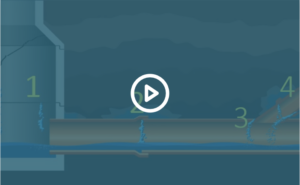Pipe Rehabilitation
Pipeline rehabilitation is available for mainline, lateral, and potable water applications. There are a variety of technologies and solutions available, because no two projects are the same. After careful assessment, decisions may be made regarding the safest, longest-lasting and most cost-effective technology to replace an existing pipe – either with a new pipe-within-a-pipe using technology such as spiral wound pipe or cured-in-place pipe, or with technologies such as pipe bursting that replace the old pipe with a new one without digging it up.
MAINLINE
CIPP
CIPP
Heat Cured
CIPP is a thermoset resin system (polyester, vinyl ester, or epoxy) that is installed into the existing pipeline to be rehabilitated, with either a polyester felt or fiberglass tube of the approximate thickness designed for the application. The resin-saturated tube is installed either by directly inverting the tube into position using water or air pressure, or by pulling the resin saturated tube into place and inflating the tube. Once in place and properly inflated the resin system is cured using either heat (hot water or steam) or ultraviolet light. Recent technology developments include tubes that are reinforced with various high tensile fibers capable of increasing the overall strength of the finished CIPP. Because CIPP does not bond to the host pipe in sewers, groundwater may track between the CIPP and the host pipe. Supplemental technologies that provide a watertight seal between the host pipe and the new CIPP should be employed wherever groundwater infiltration may enter the collection system, such as at laterals and manholes. Seal technologies have been developed that have hydrophilic properties that can be installed in conjunction with the CIPP product.
CIPP is available in sizes ranging from 2 ” through 120″. It is most cost-effective in sizes 8″ through 48″; though it is routinely used for larger diameters due to a project’s site-specific parameters. The resin-saturated tube can be installed in a variety of common shapes for sewer lines; round, egg, arch, and elliptical. Square or rectangular pipes can be lined but can provide many challenges to fitting the CIPP tightly. Multiple bends up to 90° and transitions in size and shape have been accomplished successfully and can be accommodated by fabricating the tube accordingly.
Typically, the house service connections are reconnected robotically, requiring no excavation.
Hundreds of millions of feet of CIPP are in service throughout the world today, and it is considered the most widely accepted pipeline rehabilitation technology worldwide. CIPP has been installed successfully in continuous lengths of over 2500 LF
CIPP Temperature Sensor Strips
Sensors are strung via a cable, inside the pipe that is to be repaired, prior to insertion of the CIPP liner. Once the liner is inserted, and the heating process via steam or water has started, temperature readings from the sensors that are distributed all along the pipeline are transmitted to an on-site computer. Designed to monitor the CIPP wall temperature during curing of the pipe in the field, the technology is a CIPP cure measurement technique using a 3mm diameter probe that is pulled through the pipeline to be rehabilitated. Temperature is measured every 1.5 feet, displaying the average temperature across each 1.5-foot section of the liner. The sensor wire is pulled into the host pipe, then the liner is installed over the wire. Temperature readings are displayed on a computer connected at the end of the sensor wire.
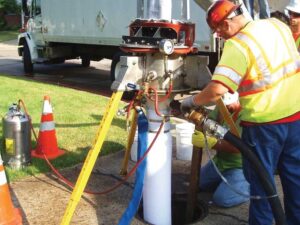
Ultraviolet Light Cured
The liner is typically winched into place using a constant tension winch, then inflated using air pressure. A special light train, including CCTV, UV lights, and infrared sensors is pull through the inside of the inflated liner before it is cured. The uncured liner is televised to determine if there are any defects before curing. The UV lights, on the light train, are turned on and the train is pulled back through causing the liner to cure. Infrared sensors record the entire cure process
Equipment
Installation Equipment
Installation equipment for water and air installations has improved over the years. Newer equipment is more compact and is operated using pump pressure in lieu of static pressure.
Light Curing Equipment
Cured-in-place-pipe (CIPP) cured with ultraviolet light is expanding the market by offering an additional rehabilitation option. UV curing technology is widely used in Europe and its use is now gaining traction in North America.
This rehabilitation method uses a light train that emits ultraviolet light as it is pulled through the flexible, resin-impregnated liner. The UV light causes the liner to cure and harden forming a new tight-fitting, joint-free pipe.
Light trains with various configurations are now available to match the pipe diameter and profile. An integral video camera allows inspection of the pipeline while the train is initially pulled through the inflated liner. This ensures that the liner is properly fitted. Adjustments to the liner can be made before the curing process begins.
After the initial inspection, the UV lights are powered up and the train is pulled back through the pipe. A computer controls the speed of the train, predetermined by the diameter of the liner. The curing speed, liner pressure, ambient and liner wall temperature, and light settings are carefully regulated and monitored. The computer logs the inspection video and data to provide complete documentation.
Various UV curing systems are offered to meet application requirements. A portable unit can be trailer-mounted or retrofitted to an existing truck. This system, for lining pipe diameters from 6- to 18-inches, controls the light train speed and powers the UV lights on the light train. It includes a monitor, automatic cable feed and 100 m (328 feet) of cable.
The truck-mounted system provides a professional platform for lining pipe with diameters to 60 inches. The reel assembly contains 200 m (565 feet) of cable, with an option for 300 m (985 feet). The unit ensures that the light train is retracted through the pipe at the preset speed to exactly meet the prescribed curing time. The electronic panel inside the control room monitors and records the curing process, controls the UV lights on the train, and displays and logs the inspection video and data. An 80 kW diesel generator powers the mechanical systems, the CCTV camera and the UV lights. The blower system is sized to accommodate large lining for pipe diameters to 60 inches.
The complete system typically includes two light trains and two sets of packers with air couplings.
Mainline/Lateral Connection Lining
Main/lateral connection lining is a process that is commonly used to address structurally inadequate, broken, cracked or improperly installed conditions of the connection between a lateral pipe and the mainline pipe. It is also used to connect the mainline pipe with laterals.
Lateral connection CIPP is commonly used to repair broken service taps where they enter the mainline, and to connect mainline linings with lateral liners to establish a watertight connection between the two systems. They are also used to stop leakage between the installed liner and the host pipe from entering the sewer at the service connection. A sealing technology should be used together with the connection lining. The connection liner may be shaped like a hat or a structural full-circle repair, and typically consists of a polyester/fiberglass assembly which is impregnated with a curable liquid resin. These technologies may incorporate hydrophilic gasket or grout or resin paste injection sealing technology, ensuring a non-leaking connection, and are installed using ambient, heat or ultra-violet light curing techniques. Each type of sealing technology, must however, be evaluated and selected for its recommended application and proven long-term capability. Lateral connection lining installation can be performed with or without the use of a cleanout.
How It Works:
- A lining method is chosen:
- Brim Style Liners (shaped like a hat brim and formed to the inside of the mainline pipe around the lateral opening); or
- Full Circle/Wrap Style Liners (inserted tightly inside the lateral and into a full circle around the inside of the sewer main)
- The liner is impregnated with resin and then positioned over the lateral from the mainline (no excavation is necessary)
- Using a bladder, the liner is inverted or inserted up the lateral and pressed tightly against the inside of the pipe
- The liner is then cured using ambient temperatures, heat or light
- The finished connection liner can eliminate infiltration and root intrusion
Sectional Lining
A number of different trenchless technologies are available that are specifically designed for the repair of pipe joints and/or localized pipeline defects. They can vary in length from several feet to 30 feet or longer and can be provided with O-ring-type seals installed at the ends of the sectional liner.
Inverted sectional liners are available in a variety of lengths, sizes and thicknesses to accommodate the needed structural repair. The liner tube is vacuum saturated with resin in the field with an approved thermoset resin and loaded into a flexible air inversion launcher. The launcher is pulled through the pipe to the point of repair; air pressure is applied causing the liner tube/bladder tube to invert through the defective pipe section. The liner is held under pressure until cured, approximately two hours at ambient temperatures, or the liner may be steam cured, reducing cure time from two hours to as little as 30 minutes.
Short sectional liners are saturated in the field, typically with an epoxy resin system, wrapped around an inflation packer and winched into the existing pipeline to the defective section. The packer is then inflated, and the resin is allowed to cure (typically two hours @ 75°F) depending on the temperature of the sewer. Heated packers can be used to speed up the cure time. The key to effective installations is to thoroughly understand the effects of temperature on the cure time for the short liner repair system. Some short liners use ultraviolet light cured systems. The short liner is installed in the pipe and positioned over the defective area. Once in place the ultraviolet light is switched on and the short liner is cured in less than 10 minutes. Short liners can be used for patching pipe joints, pipe leakage, mis-cut service connections and any defect that may need repair in the pipeline
Spray Applied Pipe Lining (SAPL)
Spray applied linings come in several forms, typically falling into either cementitious or polymer resin categories. They can be designed as corrosion-resistant coatings or as fully structurally independent depending on the material and project requirements. The materials can be applied by centrifugally casting (rotary spray), hand spray or troweling. These materials are used extensively in large diameter sewers, culverts, and drainage structures. Typically, applications for pipes 36” or larger.
Cementitious: (Cement and Geopolymers)
A common practice from the early 1900s included lining with portland cement Shot-crete (Wet Process) or Gunite (Dry Process). These have evolved to prepackaged lining mortars passed either on portland cement (OPC) or geopolymer formulations. They can be applied in multiple passes as structurally independent designs for gravity systems. Some mortars have inherent corrosion resistance to H2S environments while others use anti-microbial additives to obtain resistance.
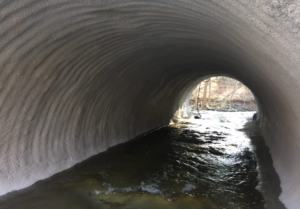
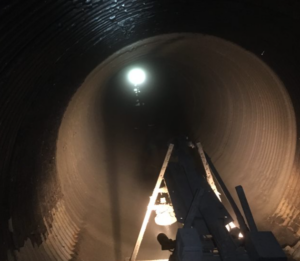
Polymeric:
Epoxy:
Solvent free (100% solids) coatings are operator and environmentally safe and require no evaporative curing process making them ideal for underground coating applications. These high build coatings are either spray or trowel applied and can be specified at structurally enhancing thicknesses. Current generations of epoxy coatings will adhere to moist or damp substrates and have excellent chemical resistance and long-term physical properties.
Urethane:
These materials are typically spray applied. Many variations are available from elastomeric to rigid formulations. Generally, they are 100% solids only used for underground coating, but can be adapted to use in environments where UV exposure exist. They have good to excellent chemical resistance and elastomeric qualities that range from rigid formulations to highly flexible. Urethanes generally have strong long-term physical properties. A hallmark of the urethane family is their quick-curing capacity which allows for a rapid “return to service” for the structures that are coated.
Folded Thermoplastic Pipe
Folded Pipe Liners are thermoplastic materials that can be used in gravity sewers, culverts, industrial pipelines, sewage force mains and water lines.
How It Works:
- Folded pipe liners are extruded round, and typically deformed and spooled
- Liners are re-rounded with controlled steam and pressure
- The outside diameter fits snugly against the existing pipe
HDPE
Folded high density polyethylene (HDPE) is commercially available in sizes ranging from 6″ through 24″. The most common sizes used for sanitary sewer lines are 6″ through 12″. The larger diameters are typically used to renovate pressure pipelines and culvert piping. Folded HDPE is extruded in a round shape, folded and coiled on reels for delivery to the project site. In the field the folded pipe is winched into place and then un-folded to fit tightly within the host pipe. The un-folding process is accomplished by the application of air pressure and steam. In order to ensure a tight fit and no post-installation movement of the liner, a precise re-rounding procedure, to anneal any residual installation stresses and stretch of the HDPE pipe, is performed by the contractor. The liner is typically sized 2-2.5% smaller than the host pipe to ensure a tight fit, which limits the amount of stretching required, providing a consistent wall thickness. Typically, the house service connections are reconnected robotically requiring no excavation.
PVC
Folded polyvinyl chloride (PVC), depending upon the manufacturer, is available in size ranging from 6″ through 24″ and in some cases up to 30”. For sanitary sewer applications it is typically installed in sizes 6″ through 15″. Bends up to 90° can be accommodated. Folded PVC is extruded in a round shape, deformed, and coiled on reels for delivery to the project site. In the field the coil of pipe is placed into a steam cabinet to soften the material to allow it to be winched into place. The folded PVC is then reformed to tightly fit the host pipe using air pressure and steam. Typically, the house service connections are reconnected robotically requiring no excavation.
Materials are shelf-stable and able to be reprocessed. Thermoformed liners have been installed successfully in continuous lengths up to 1500 LF.
Injection Grouting
Injection grouting is a soil sealing process with a two-component chemical grout injected under low pressure through joints and pipe defects. The grout travels into soils and voids around mainline pipe, laterals, lateral connections, manhole structures and into lined pipe annulus to stop leaks, stabilize soils and control infiltration. The sealing is achieved by filling voids between the soil grains on the exterior of the structures creating a waterproof barrier. Grout mixes, additives and grouting techniques provide long lasting repairs.
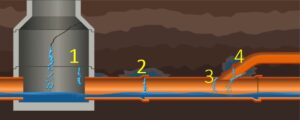
While many pipelines may appear structurally sound, the joint integrity (water-tightness) can be lost due to the deterioration of the joint seal material, voids on the exterior, or other factors. As a result, infiltration and soil fines will find their way into the pipeline reducing system capacity and effecting structural integrity. Infiltration is the root cause of structural decay, and grouting is most cost-effective trenchless technology prior to structural demise of the collection system.
Injection grouting has been used successfully for more than 60 years by many utilities across North America. The key to the successful use of injection grout is in choosing the right grout mixes and pumping procedures to ensure that the void in the soil surrounding the joint is properly filled.
As the first defense against infiltration, a holistic approach with injection grouting at all four points of entry – mainlines, laterals, service connections, and manholes – will extend the service life of the underground assets, reduce flow to Waste Water Treatment Plants (WWTP), maintain system capacity, decrease the frequency of cleaning, and minimize the cost of water treatment.
Mainline Grouting
Mainline grouting is executed using a grout truck, inflatable mainline packer, and a two-component chemical grout. Closed-circuit television (CCTV) is utilized inside the pipe to locate the joint, defect or crack to be tested and/or injected, and strategically positions the packer in place. It is important to air test all joints and to seal those that fail. Joints that fail the air pressure test can immediately be injected and sealed with grout. Grout is pumped under pressure through the defects into the surrounding soils forming an impermeable waterproof barrier, while stabilizing the pipe in the sewer trench. After the joint or defect is sealed, a post-air pressure test is performed to confirm the seal. Once documented, the packer is deflated and moved to the next joint or defect in the pipe to repeat this process.
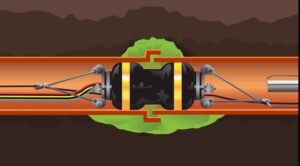
Service Laterals and Connections from the Mainline
Lateral grouting is completed much like mainline grouting, except the packer has an inflatable bladder that extends a specified distance up the lateral connection from the mainline. The top, ribbed portion of the lateral bladder expands, seating against the pipe wall, while the remaining length expands less than the diameter of the pipe to create a thin annulus for the grout to travel. Grout is pumped under pressure through the defects into the surrounding soils forming an impermeable waterproof barrier, while stabilizing the pipe in the sewer trench. After the lateral connection and defects are sealed, a post-air pressure test is performed to confirm the seal. Once documented, the packer and lateral plug are deflated and moved to the next lateral connection in the pipe to repeat this process. As an added benefit, lateral grouting is used to seal the annular space in relined pipes after lateral reinstatements.
Pipe Replacement
Pipe Bursting
Pipe bursting is referred to, by many, as trenchless technology whereas it really is “less trench” technology. Translated this means that there is some excavation required but significantly less than traditional dig and replace methods. Pipe bursting, mostly applicable to replacing “friable” or “brittle” materials, is also sometimes referred to as “Pipe cracking”. “Pipe splitting” more correctly refers to replacing such materials as ductile iron, plastic and steel pipes.
Unlike lining system technologies, pipe bursting is a pipe replacement system. The existing host pipe is fractured or displaced with a new pipe, manufactured from a variety of factory produced materials. These new pipe materials are designed to sustain the full loading conditions encountered in a pipe replacement project.
Pipe bursting is a unique pipe replacement system. Unlike most pipe renewal technologies, pipe bursting allows the customer to replace an existing pipe not only with a new pipe using a number of different pipe materials, but also a larger pipe, with higher flow capacity.
Pipe bursting has been used commercially since the 1970s in Europe. In the early 1980s pipe bursting became more popular and was used to primarily burst thousands of miles of defective, cast iron gas main for British Gas in England.
Until the late 1970s and early 1980s sewer renewal in the United States was accomplished primarily by digging the old deteriorated pipeline and replacing it with newer pipe materials. With directional drilling developed in the U.S. as an effective tool for the replacement of small diameter gas mains, the need for pipe bursting was not immediately apparent.
Initially pipe bursting was primarily used in the replacement of friable type pipe materials that would crack or shatter to allow for insertion of a replacement pipe material such as cast iron, concrete, cement, clay and others. Over subsequent years the pipe bursting technology has expanded to include the replacement of such materials as ductile iron, steel and plastic pipe materials. The pipe bursting technology can be applied to water mains, water service connections, sewer mainline, sewer laterals, gas mains, gas service connections, industrial, telephone and other applications.
Pipe Reaming
Pipe reaming technology incorporates the use of directional drilling equipment together with an aggressive pipe grinding head that pulverizes the existing pipe. Using appropriate fluids, the operation produces a liquid slurry, which then is pumped from a receiving manhole during the installation operation. During the reaming operation the existing pipe is ground out and not expanded into the surrounding soil making it an ideal method for tight utility locations and pipelines constructed through encasements, near non-compressible structures and soil and for pipe previously constructed in a rock trench.
Pipe Splitting
Pipe splitting technology is a system that uses static pressure to cut and split the existing pipe, expand it out and insert a new structural replacement pipe material. The system is designed to allow upsizing of existing mains thereby improving capacity and flow characteristics
A variety of materials can be used with the technology including HDPE, ductile iron, steel and plastic pipe. Service taps are typically excavated and re-connected to the newly installed pipe.
Sliplining
Continuous
One of the older technologies, continuous sliplining pipe is available in sizes ranging from 4″ through 60″. Continuous sliplining is installed using a number of different materials including HDPE, fused PVC, restrained joint PVC, ductile iron and steel. HDPE is still one of the more popular materials installed using the sliplining technique. In the case of HDPE, lengths of round pipe are fused together to make up the length of the pipeline being rehabilitated. The fused liner is winched into place and the ends sealed. Sliplining results in a smaller pipe being pulled into the existing pipe and some final capacity loss should be anticipated. In some cases, the annulus is grouted. Service re-connections are typically accomplished by excavation.
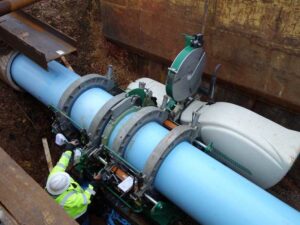
Segmental
Segmental pipe is available in sizes ranging from 12″ to 102″ and is accomplished using short lengths of profile wall PVC or GRP. Profile wall PVC is applicable to round pipe restorations while the GRP systems can accommodate round, egg, arch, and elliptical shaped host piping. The annulus is grouted and the ends sealed. Bends and transitions in size can be accommodated by the GRP systems, as well. Service re-connections are typically accomplished by excavation.
Sectional
Sectional pipe sizes range from 12” to 120” (or larger) with panel systems for the larger sizes. This process is generally accomplished by inserting short lengths of PVC or GRP pipe or panels through existing manhole openings. The panel systems typically have two or more pieces making up a “ring” that is assembled inside the pipeline. After these systems are put into place, a non-shrink grout is pumped into the annulus. These systems are applicable to round, rectangular, egg, arch and elliptical shaped host piping. Bends and transitions in size can also be accommodated by the panel systems. Service re-connections are typically accomplished by excavation.
Spiral Wound Pipe
Spiral Wound is a trenchless pipelining method for sewers, storm drains and culverts. Spiral Wound trenchless technology provides fully structural rehabilitation using mechanically wound PVC.
The Spiral Wound process is 100% mechanical and can be installed in live flow. Pipe liners are constructed directly onsite using only existing access points, such as a standard manhole. This method meets design standards such as F1741 and F1697, specifying the proper installation of mechanically and machine wound PVC profiles.
The Spiral Wound technique forms a continuous strip of PVC profile into a fully structural liner by using machinery. The PVC profile can be steel reinforced to meet more stringent loading conditions. Mechanical Spiral Wound lining meets the material and installation standards detailed in F1697 and F1741. As stated in the ASTM, Spiral Wound can be designed for fully deteriorated and partially deteriorated applications. For fully deteriorated, the PVC liner is designed to resist all applied loads since the existing pipe is not structurally sound. Spiral Wound Lining can be completed with minimal impact on the surrounding environment and does not require chemicals to solidify the new pipeline.
Spiral Wound Lining Process
A spool above ground feeds a continuous strip of PVC strip through existing access points. No further site excavation is necessary.
The winding machine forms the liner directly inside the sewer, storm drain or culvert. Liner is either pushed down the pipeline or pulled using a traversing machine. The method used depends on the upon host pipe diameter.
The profile edges are locked during winding, creating a water-tight seal. The pipe liner is either installed as a tight fit or requires annular space grouting to finish the installation process.
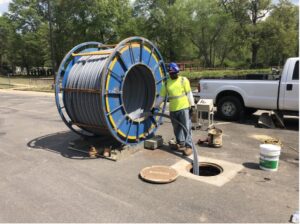
Trenchless Lining Methods
3 Spiral Wound installation methods based upon pipe diameter.
6″- 42” Expandable, Grout less fully structural solution
Stationary winding equipment constructs a tight-fit liner suitable for small-diameter sewers, storm drains, and culverts. It does not require annular space grouting. The PVC profile is wound directly into the host pipe by the hydraulic winding machine in the access chamber.
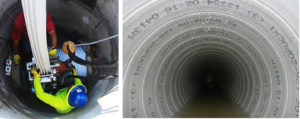
40″-60″ Tight-Fit Grout less Fully Structural Solution
This method is a trenchless pipeline rehabilitation method for mid-range diameter sewers, storm drains, and culverts that do not require annular space grouting.
This method uses two different winding machines that traverse the pipeline while constructing a tight-fit liner.
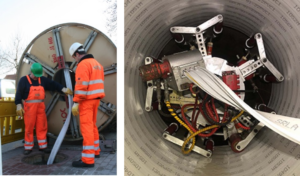
32″-200″ + Round and Non-Round fully structural liners
Used for the repair of large diameter round and non-round sewers, storm drains, and culverts.
The PVC profile and the shape of the liner is wound into the pipe by a traverse winding machine. Cellular or structural grout fills the annular space.
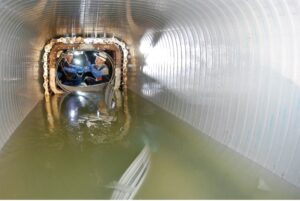
Spiral Wound Technology Video
Learn more about spiral wound pipe technology – a proven and effective way to repair underground pipes while minimizing disruption to surrounding areas.
Grout In Place Lining Systems (GIPLS)
A GIPLS is typically composed of a thin sheet of plastic, either PVC or HDPE, which is bonded to a structural grout layer. The GIPLS is a composite structure with the original pipeline. Owing to its method of installation (forms are typically constructed to support the grouting operation), it is typically limited to worker-entry size piping. The exception to this is the PVC spiral wound-in-place system, which can be installed in sizes starting as small as 8″.
Segmental Panel
Segmental panel systems are a series of molded or translucent PVC panels, that when assembled, form a new pipe or culvert within the existing damaged structure. A structural grout may be used to fill the annular space between the new segmental panel pipe and its host. This restores the structural strength of the original pipe, as well. The unique see-through walls allow visual monitoring the grouting process
Joint / Spot Repairs
Mechanical Seals
These type repair systems can be installed either using a crawler-deployed inflation type packer or by worker entry. Joint seals can vary in size from as small as 6” to over 200” in diameter. These seals typically require trained and experienced personnel to insure proper installation of the products. Some of these technologies have been available in the market for over 30 years with a long installation history for both water and sewer applications. Materials will vary including stainless steel, PVC and rubber. PVC systems can be installed in a variety of shapes and sizes.
Joint Seals
The internal joint seal is typically manufactured of EPDM or polyisoprene rubber and the expansion bands used to compress the rubber against the pipe wall are 14 gauge 304 or 316 grade stainless steel. In this manner, it provides both structural repair and abatement of infiltration. Unlike other rehab technologies, a mechanical sleeve requires no digging, resin mixing, cure time, or bypass pumping; has no pot life; and can be installed amidst active infiltration without the risk of wash-out. Mechanical sleeves are ideal for addressing infiltration, offset joints, root intrusion, abandoned laterals, and longitudinal and circumferential cracks.
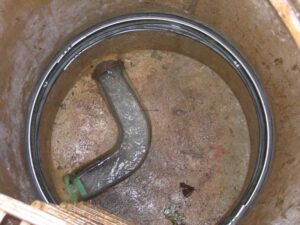
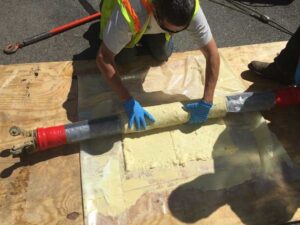
Laterals
Lateral liners, like mainline CIPP, can be used with hydrophilic materials to prevent ground water from infiltrating into the lateral pipe. Lateral CIPP also requires the same quality installation and a trained inspector to observe, verify, inspect, document and test the installation of a lateral rehabilitation liner.
CIPP
CIPP Lateral Lining
Cured-in-Place Pipe (CIPP) lateral lining is a technology that rehabilitates existing lateral pipes while minimizing disruption to yards, sidewalks and driveways. CIPP lateral lining is appropriate when the host pipe has experienced cracks, fractures or holes but has generally maintained its original shape.
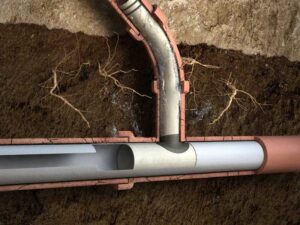
How It Works:
- A tube is manufactured to the required length and diameter, typically 2” – 8” (50 – 200 mm)
- The tube is vacuum impregnated with resin, passed through a calibration roller, then inserted (pulled-in or inverted) into the existing pipe
- The tube is installed into the lateral from the house or cleanout, or from the mainline sewer, then pressurized against the host pipe.
- Using ambient temperature, steam, hot water, hot air or light, the tube is then cured in place
- The finished CIPP can provide a structural replacement and prevent infiltration and roots
- A renewed lateral pipe using CIPP technology has a minimum life expectancy of 50 years or more
Lateral And Main/Lateral Connection Lining
Repair by lining a portion of the lateral pipe or the entire lateral pipe and also lining the main/lateral connection
Main/Lateral Connection Sealing
Repair by sealing the main/lateral connection by use of hydrophilic gasket or paste materials.
Cleanout Installation
Trenchless cleanouts are an alternative to digging, shoring, and using trench boxes for installing a lateral cleanout. Cleanouts typically can be installed in two hours with a small footprint and restoration is performed in the same day.
The method consists of locating a lateral pipe and utilizing a vacuum excavator to make a 20-inch hole exposing the lateral pipe. A tapping saddle and riser pipe are remotely attached using a water activated adhesive as the saddle is inserted into the bore-hole and snapped onto the lateral pipe. A leakage test is typically performed before the lateral pipe is cored to complete the installation.
Pipe Bursting
The replacement of a section or an entire lateral pipe by pipe bursting. Several of the technologies provide either pipeline rehabilitation or a watertight seal solution. Some technologies provide solutions to both. Owners must determine their expectations for a rehabilitation project in order to select the best, most applicable products and technologies.
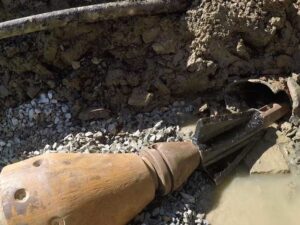
For example, if the goals of the project are to reduce infiltration entering the sewer system, then the technologies that provide a long-term watertight seal should be selected. If the goals are to renew the pipe structurally to as good as, or better than, original condition, then the technologies with proven and accepted design and service life concepts should be selected. The goal may be to eliminate both infiltration and rehabilitate the pipe to original standards. Many lateral rehabilitation technologies provide structural replacement or leakage control for the design and service life as determined by the manufacturer of the product and the expectations of the owner. Field tests should be required by the owner to confirm specified technology performance.
Sliplining
Continuous
One of the older technologies, continuous sliplining pipe is available in sizes ranging from 4″ through 60″. Continuous sliplining is installed using a number of different materials including HDPE, fused PVC, restrained joint PVC, ductile iron and steel. HDPE is still one of the more popular materials installed using the sliplining technique. In the case of HDPE, lengths of round pipe are fused together to make up the length of the pipeline being rehabilitated. The fused liner is winched into place and the ends sealed. Sliplining results in a smaller pipe being pulled into the existing pipe and some final capacity loss should be anticipated. In some cases, the annulus is grouted. Service re-connections are typically accomplished by excavation.

Segmental
Segmental pipe is available in sizes ranging from 12″ to 102″ and is accomplished using short lengths of profile wall PVC or GRP. Profile wall PVC is applicable to round pipe restorations while the GRP systems can accommodate round, egg, arch, and elliptical shaped host piping. The annulus is grouted and the ends sealed. Bends and transitions in size can be accommodated by the GRP systems, as well. Service re-connections are typically accomplished by excavation.
Sectional
Sectional pipe sizes range from 12” to 120” (or larger) with panel systems for the larger sizes. This process is generally accomplished by inserting short lengths of PVC or GRP pipe or panels through existing manhole openings. The panel systems typically have two or more pieces making up a “ring” that is assembled inside the pipeline. After these systems are put into place, a non-shrink grout is pumped into the annulus. These systems are applicable to round, rectangular, egg, arch and elliptical shaped host piping. Bends and transitions in size can also be accommodated by the panel systems. Service re-connections are typically accomplished by excavation.
Folded Thermoplastic Pipe
Folded Pipe Liners are thermoplastic materials that can be used in gravity sewers, culverts, industrial pipelines, sewage force mains and water lines.
How It Works:
- Folded pipe liners are extruded round, and typically deformed and spooled
- Liners are re-rounded with controlled steam and pressure
- The outside diameter fits snugly against the existing pipe
HDPE
Folded high density polyethylene (HDPE) is commercially available in sizes ranging from 6″ through 24″. The most common sizes used for sanitary sewer lines are 6″ through 12″. The larger diameters are typically used to renovate pressure pipelines and culvert piping. Folded HDPE is extruded in a round shape, folded and coiled on reels for delivery to the project site. In the field the folded pipe is winched into place and then un-folded to fit tightly within the host pipe. The un-folding process is accomplished by the application of air pressure and steam. In order to ensure a tight fit and no post-installation movement of the liner, a precise re-rounding procedure, to anneal any residual installation stresses and stretch of the HDPE pipe, is performed by the contractor. The liner is typically sized 2-2.5% smaller than the host pipe to ensure a tight fit, which limits the amount of stretching required, providing a consistent wall thickness. Typically, the house service connections are reconnected robotically requiring no excavation.
PVC
Folded polyvinyl chloride (PVC), depending upon the manufacturer, is available in size ranging from 6″ through 24″ and in some cases up to 30”. For sanitary sewer applications it is typically installed in sizes 6″ through 15″. Bends up to 90° can be accommodated. Folded PVC is extruded in a round shape, deformed, and coiled on reels for delivery to the project site. In the field the coil of pipe is placed into a steam cabinet to soften the material to allow it to be winched into place. The folded PVC is then reformed to tightly fit the host pipe using air pressure and steam. Typically, the house service connections are reconnected robotically requiring no excavation.
Materials are shelf-stable and able to be reprocessed. Thermoformed liners have been installed successfully in continuous lengths up to 1500 LF.
Equipment & Materials
Self-Propelled Cutter/Camera Robots
State-of-the-art self-propelled, remote operated cutting tools are specifically engineered to remove protruding taps, trim off-set joints smooth prior to CIPP lining, and quickly reinstate service connections. These grinding/cutting robots are outfitted with a pan/tilt camera that includes a lens washing device, allowing one single unit to perform pipe rehab work by accessing only one single manhole, and ensuring the operator has a clean, clear view of the robotic work being performed. These robots are also capable of cutting straight forward and 360-degrees, enabling the robot to grind and crawl through collapsed cured-in-place pipe linings. Robots today are outfitted to insert mechanical plugs up into service lateral connections, grind, trim, reinstate, chisel, video inspect and install main to lateral CIPP connection seals.
Insertion Saddle Tee Connection
The saddle tee connection is a three-piece compression fitting designed to give the installer a water-tight, air-testable connections to any type of mainline pipe. Lateral connections are available in 2” through 30” in size for virtually any type of commonly used pipe. Installation of the tee requires that a hole be cut into the mainline to match the size of the lateral. The hole-saw must be ordered from the manufacturer, as they are size specific to the fittings. They are available in all configurations, depending on the type of material being cut. Once the hole is cut, the rubber sleeve is installed into the host pipe. There are guide lines and installation instructions supplied with every fitting. After the sleeve is installed, the PVC hub is installed using a small mallet. This part of the installation gives the fitting the necessary compression against the side wall of the host pipe, ensuring the water-tight seal. A stainless-steel band is installed last, before the fitting is ready for backfill.
Manhole End Seals For Pipe Liner Installations
Manhole end seals for pipe liner installations provide a water-tight seal of the liner pipe at the manhole wall. Some end seals are constructed for the mainline and manhole connection in the shape of a low-profile sleeve consisting of a hydrophilic neoprene material that swells upon contact with water, creating a compression gasket seal similar to that of new pipe installation.
Other designs include an internal rubber seal that is installed over the liner and the host pipe. This unique design captures the rubber and compresses it against the host pipe and new CIPP liner creating a permanent mechanical seal.
Cured-in-place pipe seals can be used to repair minor defects in unlined pipes close to their junction with manholes and can be used to seal CIPP to manhole walls or manhole liners.
Lateral Injection Grouting
Service Laterals and Connections from the Mainline
Lateral grouting is completed much like mainline grouting, except the packer has an inflatable bladder that extends a specified distance up the lateral connection from the mainline. The top, ribbed portion of the lateral bladder expands, seating against the pipe wall, while the remaining length expands less than the diameter of the pipe to create a thin annulus for the grout to travel. Grout is pumped under pressure through the defects into the surrounding soils forming an impermeable waterproof barrier, while stabilizing the pipe in the sewer trench. After the lateral connection and defects are sealed, a post-air pressure test is performed to confirm the seal. Once documented, the packer and lateral plug are deflated and moved to the next lateral connection in the pipe to repeat this process. As an added benefit, lateral grouting is used to seal the annular space in relined pipes after lateral reinstatements.
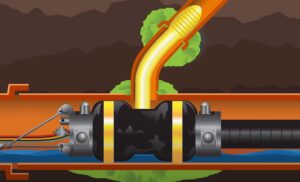
Service Lateral Grouting from above ground access (Cleanouts)
From an above ground access, a flexible push /pull packer is inserted and pushed/pulled to the furthest lateral joint downstream. The packer is inflated and the end bladders expand against the pipe wall typically providing a 3 or 5 foot long grouting chamber. The 3-5 foot span is air tested and if that area fails, grout is pumped under pressure through the existing lateral pipe defects. A post airtest is then performed to confirm the seal. The packer is then deflated and pulled back by 3 or 5 feet (length of the grouting chamber) or to the next lateral upstream joint, where the operation is repeated. This technique is not used to seal the lateral connection to the mainline sewer.
Water Main Lining
Most water main lining technologies require that the existing pipe be thoroughly cleaned and prepared for application of the coating. Some cleaning techniques include: hydraulic, mechanical, chemical, swabbing, scraping, pigging and air scouring.
Cement Mortar
Generally, a type I/II or type V Portland cement is used, depending upon the salinity of the liquid flowing through the line. Specialty cements are available to withstand high temperatures, heavy salinity concentrations, and hydrogen sulfide gas and associated corrosives.
This system is used for the internal sealing and corrosion protection for water lines first installed as early as 1930 in the USA.
Cured-In-Place Pipe
Cured-in-place liner systems are typically installed in pipe sizes of 6”-12”. These liners span and seal leaking joints, pinholes and minor cracks. Services/laterals are reinstated from inside the pipe with no excavation typically required except for access pits. Resins used with potable water are typically NSF 61 approved resin systems. Installation lengths of up to 500 feet are not unusual and liners can negotiate bends in the existing main.
Larger liners up to 48 inches in diameter are also available and can be a structural solution to rehabilitate water mains. Glass fiber reinforcement gives the liner static, self-supporting properties and allows it to withstand higher internal and external pressures than traditional liners. An individual pipe can be up to 800 feet in length.
Epoxy Lining
Spin cast pipelining technology combines specially designed equipment with proven processes for the cleaning, preparation and application of an ANSI/NSF Standard 61 approved epoxy to deteriorated 3” to 36” diameter pipes. Metal and cement-based gravity and pressure pipes can be lined in both horizontal and vertical configurations.
In 2007, the AWWARF study, “Service Life Analysis of Water Main Epoxy Lining” [Project #2941] estimates a 50-year design life for epoxy. The epoxy will provide a high level of water quality that will not affect pH levels.
Internal Joint Seals
Internal joint seals require worker-entry for Installation. The seal bridges the existing joint with a rubber material allowing continued movement of the pipe joint. Internal seals typically provide a bottle-tight, leak-proof joint repair and can withstand both internal and external hydrostatic pressures.
Modified Sliplining
The PE or PVC material is either site or factory folded or radially reduced prior to insertion into the host pipe. With the pipe liner profile reduced in size, allowing for an easier installation, the pipe liner is inserted utilizing techniques similar to that used in traditional sliplining applications. Air or water pressure and/or steam are used to revert the liner back to its original round shape, thereby forming a close fit with the host pipe. The new liner isolates the flow stream from the host pipe wall, eliminating internal corrosion and typically providing a full structural renovation solution.
In addition, the new liner allows for service connections to either be reinstated externally to the new liner or reinstated internally with newly developed robotic technologies.
Sliplining
The sliplining method incorporates the installation of a smaller or reduced size steel, ductile iron, polyethylene, PVC or other pipe materials inside the existing pipeline. Pressure rated pipe capabilities can be selected for most main applications. In some cases, grouting is required to fill the gap between the host pipe and the new PE pipe. Very long lengths can be installed using this method. Service taps are typically excavated and directly reconnected. Sliplining can be applied in transmission and distribution mains of 6”-60” in diameter.
